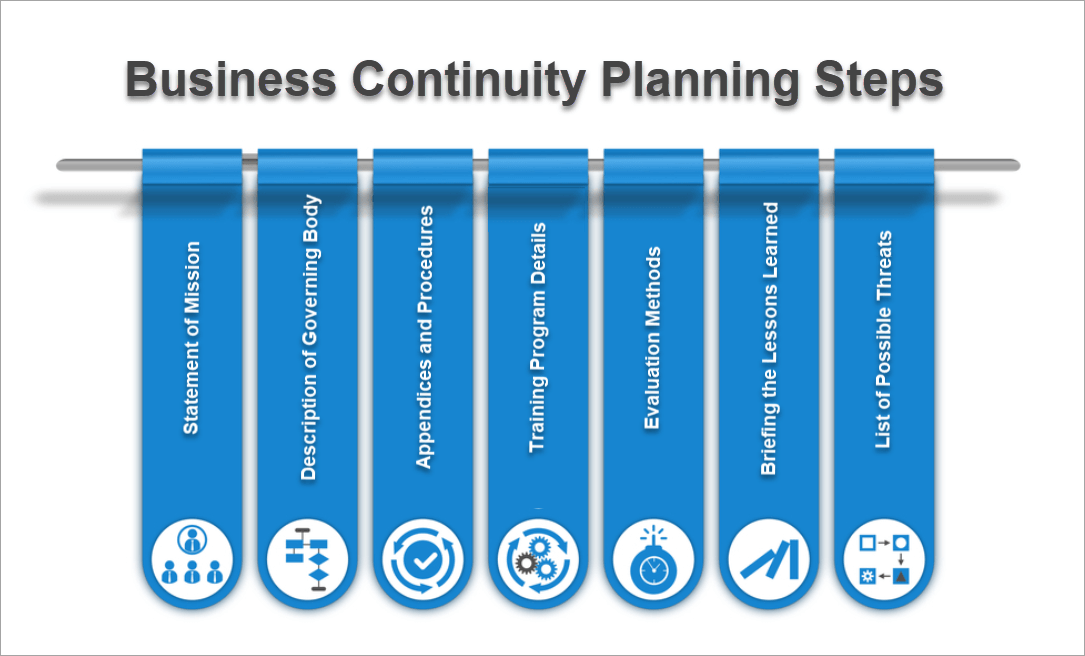No organization is devoid of the possibility of its business being affected accidentally. Business continuity planning steps are taken to immediately handle such an occurrence. Usually, a draft is prepared including these steps, formally known as BCP (business continuity plan). Documenting this layout can be traced back to the early seventies.

Jump ahead to
What Does a Business Continuity Plan Contain?
In a nutshell, BCP comprises the solutions to recover and continue business operations despite any massive intervention. This could be anything starting, from natural calamity to cyber attack. It helps an organization to stand up to the negative impact caused by such unexpected disasters.
Factors to Consider while designing a Business Continuity Plan
BCP is meant to keep a business going under all circumstances, which can be categorized into the following:
Worldwide Pandemic –
Such an extensively lasting pandemic has been a lesson for the framers of business continuity plans. The top priority of a BCP must be the arrangement for uninterrupted communication between employees. Next comes the assurance of continuity in the supply chain processes.
Natural Disturbance –
Nobody can predict the proclivity of nature in landing a phenomenal disruption. Therefore, the business continuity plan must include the timely maintenance of physical structures. This goes without saying about innovative architectural planning, as well.
Unavailability of Utilities –
Loss of power connection due to waterlogging or storms is an anticipated impediment. This leads to a lack of communication and electronic operations. Alternative solutions to these should be included while drafting the BCP.
This is a common misfortune affecting modern-day organizations. With the growing use of IT, cyber security risks have risen. Data theft is the worst of all since no business can properly function without it. So, organization should consider armoring their technical infrastructure from the start.
How Do You Benefit from a Business Continuity Plan?
A framework for business continuity planning steps is no addition but a necessity for every organization. Say, a website stops functioning for a day due to a DDoS attack. The loss it causes to a business is the same as that caused by a fire in a warehouse segment. Therefore, a BCP must be ready at hand to facilitate emergency responses.
Uninterrupted Business –
A crisis cannot stand in the way of a business’s regular workflow if organization framed a business continuity plan beforehand. It focuses on the coordination between the business owner and his HR resources. This reduces the financial loss while assuring the employees and customers about operational stability.
Maintains Brand Reputation –
Disasters are the testing periods for renowned brands/ businesses when these are most looked out for by consumers. They enquire if their favorite brand can continue providing service. A business continuity plan keeps the organization active on the public front.
Lessens Financial Risk –
BCP makes it easy to restore an organization’s functionality. The lesser the downtime, the less will be the amount of financial loss faced. Alternative means to avoid supply chain shut-downs must be stated here. Despite transportation or manufacturing setbacks, the processes should remain unaffected.
Essential Tips on How to Write a Business Continuity Plan
While documenting a business continuity plan, one must imagine the situation in every possible crisis.
Statement of Mission
Document an elaborate description of the objectives. It should also specify the time for completing the plan. The budget availability for recovery preparation needs to be clearly stated here. Any possibility of receiving grants or available financial resources that can be used in crisis must be written down.
Description of Governing Body
The plan should present clear definitions of the roles, including the authority and succession lines. It should specify the names, designations, and contact information of every individual in the governing body. Also, mention who is accountable to whom in the plan as proof for team members. This avoids confusion, and each member knows his part.
Appendices and Procedures
These form the crux of a BCP that has to be thought over very well before writing. A document must talk about resources, procedures, and agreements. One needs to keep thinking of a sequence of tasks as solutions to the anticipated disruption. Illustrations and diagrams can be used so that they are easily understood. Checklists are powerful tools for conveying information and ensuring that the tasks are performed.
Training Program Details
A training curriculum has to be included in the plan. It will elaborate on the leading roles, training recipients, and timelines.
Evaluation Methods
The business continuity plan shall contain schedules and guidelines for testing the procedures already documented. Checklists and forms for the examinees have to be assembled in the document. Reviewing the plan is necessary before finalizing it. This can be done by showing it to those who were not involved in writing it.
Briefing the Lessons Learned
Consider takeaways from past disruptions and the actions performed. These have to be specified with respect to the written procedures to be undertaken. A mere narration of the steps does not make them alluring unless they hint at the previous unpleasant experiences.
List of Possible Threats
After arriving at the possible business issues and impacts, such threats should be jotted down in the plan. This makes the loss elimination strategies in the document more lucid for the business plan creators.
BCP is a plan to help businesses function in the event of a disaster, but it is different from a disaster recovery plan. Also, it is ineffective in case of a pandemic or disease outbreak. These instructions keep not only the mind but also the organization running in a chaotic situation. Much care and effort should be put into framing a robust business continuity plan. Our Business Analysis Course curriculum offers comprehensive knowledge and Professional Training on how to write a business continuity plan.



